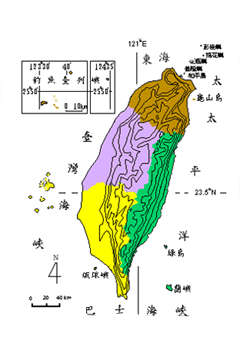The Political Geography of Taiwan

Relevant Websites
- Tai-wan-de-gu-shi-zheng-zhi-pian
- He-ping-lun-tan
- Taiwan Politics and Economics Institute
- Tai-wan-yan-yi
- The Era of Ch'ing Dynasty(State University of New York)
- Peace Forum(Division of Strategic and International Studues)
- Political Development(Taiwan Provincial Government)
Reference
- National Institute for Compilation and Translation, 2000: Ren-shi-tai-wan-li-shi-pian.
- National Sun Yat-sen University BBS (Zheng-zhi-can-kao-zi-liao)
- Chang, Sheng-yen, 1996: Tai-wan-gai-fa-shi, Taipei, National Open University
- Cheng, Da-hsueh, 1991: Tai-wan-gai-fa-shi, Taipei, Zhongwen Book Co..
Taiwan's political geography can be divided into the following four historical stages: (a) before the 17th century, Austronesian aborigines lived in their own tribes; (b) in the 17th century, the Dutch, Ming Zheng, and Ching Dynasties came to rule in succession; (c) between 1895 and 1945, Taiwan was a colony of Japan; (d) since 1945 Taiwan has been a province of the Republic of China, which separated from mainland China in 1949.
A. Before the 17th century: Austronesian aborigines
Before the 17th century, Austronesian aborigines lived in their own completely autonomous settlements. Some indigenous peoples were not deeply involved with the Han Chinese immigrants and resided mostly in the mountains, so they were referred to as "mountain tribes." They are: the Atayal and Saisiyat in the northern mountains, Bunun and Tsou in the central mountains, Paiwan and Rukai in the southern mountains, Ami and Puyuma on the eastern plain, and Yami on the southeastern islet of Lan Yu.
The Atayal tribe held senior citizen meetings to run its public affairs. The Saisiyat, Bunun and Tsou were patriarchies, each tribe relying on its own clan leaders to organize its political, economic, and religious activities.
The Paiwan and Rukai were aristocracies settling political and economic issues through tribal meetings. The Ami and Puyuma were matriarchies, yet their senior males guided the tribal summit meetings which handled public affairs. The Yami was a patriarchy without a chieftain. Its tribal order was set through natural moderation and control evolved from its society: here taboos, a sense of collective responsibility, competition for wealth and respect for the elderly all played important roles.
Besides these mountain tribes, another group of aborigines resided on the plains and were more involved with the Han Chinese. Generally called the "Pinpu tribes," they are: the Ketagalon in the Taipei basin, Kavalan on the Lanyang plain, Taojas, Hoanya, Babuza, Pazeh, and Papora in the middle part of Taiwan, and Siraya in the south. They used the "she" as their settlement unit. Despite the common practice of division into clans, it was mainly summit-level meetings attended by a select group of senior men which determined tribal affairs.
B. In the 17th century: changing authorities
a. Dutch Rule (1624-1661)
In the 17th century, the Dutch and Spanish occupied the south and north of Taiwan as trading centers on the international sea route and as domains of Christian missionary influence. Later, after the Dutch drove the Spanish out of the island, they became the sole authority in Taiwan.
The Dutch not only tried to build new cities (Zeelandia, today's Anping in Tainan) and streets (Hsinshuh Street in Chihkan) but also sent troops to attack the aborigines. Many indigenous settlements were therefore conquered or wiped out. The Dutch ruled the aborigines principally through the latter's own senior citizens, who acted as intermediaries. Their governance was also facilitated by their missionary work, with missionaries appointed as local administrators.
b. Ming Zheng Rule (1662-1682)
After the Ming Dynasty's diehard Koxinga (Zheng Cheng-kung) retreated to Taiwan and defeated the Dutch, Han Chinese institutions and systems were first introduced to the island. He set up the Chengtien prefectural government to administer the local affairs.
c. Ching Dynasty (1683-1895)
In 1683, Koxinga's son Zheng Ching surrendered to the Ching Dynasty. From then until 1886 which were set up a province, Taiwan and Penghu were prefectures under the control of Fukien province.
C. Between 1895 and 1945: Japanese colony
Japan took over Taiwan in 1895 after China under the Ching Dynasty lost the Sino-Japanese War. Taiwan residents initially tried to form a democratic state to resist the take-over but failed. Their rebellion continued for almost twenty years. With a viceroy's office in Taipei, Japan suppressed the revolt and maintained its autocratic rule for fifty years. The Japanese effectively employed their police and taxation (tithing) system to control Taiwan, thus turning it into their supply base as they advanced into Southeastern Asia.
D. After 1945: Republic of China
At the end of World War II Taiwan was restored to the Republic of China. In 1949 President Chiang Kai-shek, faced with the military support the Chinese communists were receiving from the Soviet Union, gathered his remaining followers and soldiers and sailed across the straits to Taiwan. In the hope of fighting his way back to China some day, Chiang endeavored to develop Taiwan, Penghu, Kinmen, and Matsu physically, economically, politically and militarily, with his presidential office in Taipei.
In July of 1950, Taiwan held its first election for councilors, city mayors and county magistrates. The ROC president and vice president used to be selected by the General Assembly, but since 1996 they have been directly elected by the people. Currently, Taiwan has sixteen counties, six provincial municipalities and two special municipalities.
In view of the changing international atmosphere, Taiwan has adopted a pragmatic style of diplomacy in the past half-century to ensure its status in the international community. Cross-straits relations between the ROC and PRC have also changed from the original state of military confrontation to the current one of peaceful coexistence.